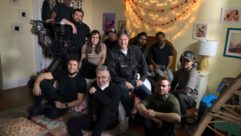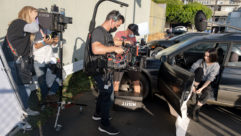As befits a drama about a sophisticated culinary critic it is the fresh palette of colorful and appetizing images that first meets the eye but these exhibit as much a love for the city of Buenos Aires as they do of gastronomic delights.
Filmmakers Gastón Duprat and Mariano Cohn (El hombre al lado, 2011; El Encargado, 2022) wanted to make Nada (aka ‘Nothing’) a series of postcards from the city.
“Naturally we wanted to make the food look good but their first call was to show Buenos Aires as a modern, romantic, and beautiful city,” explains cinematographer Alejo Maglio, ADF. “In my mind, I wanted to make a portrait of the city, of the characters, and of the dishes.”
The five-part Argentinian mini-series is made by Metrovisión for Disney+ and pairs distinguished local actor and politician Luis Brandoni with fabled star Robert De Niro.
Brandoni plays a food critic, aesthete, and all-around provocateur, who has lived for decades with a woman who handles nearly all the tasks in his daily life. But when she passes away, everything changes – and Manuel begins to discover that he doesn’t know how to do anything for himself.
“Whenever I get a script my first consideration, after talking with the director, is to decide on the lenses followed by the camera and then lighting,” says Maglio. “My belief is that the lens is the first filter of the light and that will give us the unique character of the image.”
Maglio recently shot Los Delincuentes on the ALEXA Mini and Cooke® S4/i. This heist comedy directed by Rodrigo Moreno is the Argentine entry for Best International Feature Film at the 96th Academy Awards.
“I begin by choosing the optics that will express the right mood of the image and for me, the Cooke S4® had all the perfect elements to tell that story,” he said. “For Nada, I chose the S7/i Full Frame Plus prime lenses because I knew that they were going to give me the characteristics I was looking for, something delicate and crystalline.”
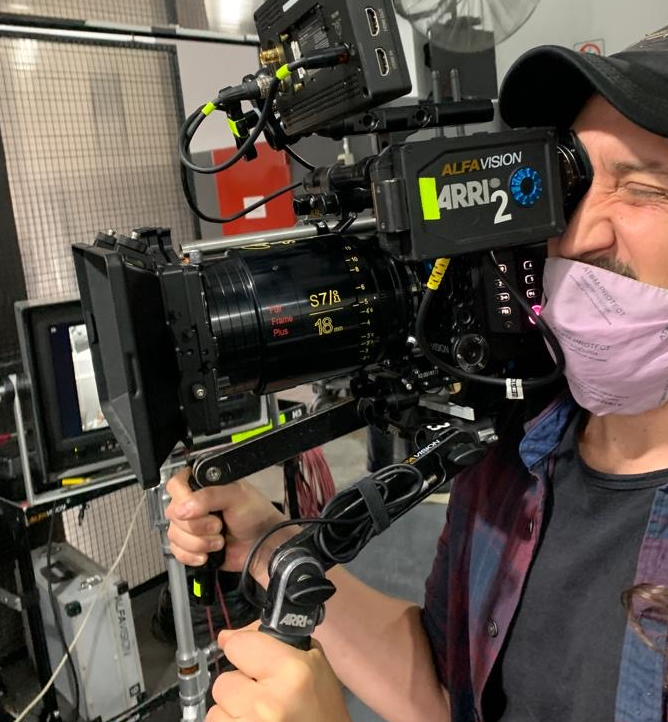
Maglio continues, “Mariano talked about our central character as an eccentric art connoisseur and said they wanted to make a postcard of Buenos Aires. My thought from there was to think of Buenos Aires as a series of still photographs and that this would translate better if we shot with Large Format (LF). The S7s were going to give me the sensation of still photography that I wanted to represent.”
Filming took place on location in Argentina’s capital but was forced into a major change just days before principal shooting began when the owners of the Kavanagh apartment building block withdrew permission to shoot.
“The apartment where Manuel lives is a key element in the story, with many scenes set there. We prepped for three months for this location, including detailed lighting plans. We had a week to find somewhere else, redesign all we had planned and make it fit in the new place with a tight schedule.”
Fortunately, they were granted use of the home of internationally famous Argentinian chef Francis Mallmann located in nearby district La Boca. In terms of décor and furnishing it could not have been more ideal.
“Francis Mallman’s home is very similar to our main character and how we had imagined his home,” Maglio adds.
In lay out, though, the apartment was long and stretched in an elegant 19th-century style called ‘Casa Chorizo’ which was a challenge for Maglio in terms of camera position and lighting.
“When you are in a large place with four square walls you can shoot in at least four different places but in this house, we only had two practical positions because if we put the camera on one wall or against one window our subjects were just too close to the camera.”
This might have been a big problem, but Maglio’s decision to use Large Format proved serendipitous. “LF helps a lot in this kind of space since we could shoot from two points of view and sometimes see the roof and the floor in the shot. In fact, we felt this added to the presentation of the apartment as a central character in our drama.”
Maglio principally used five focal lengths – 18mm, 25mm 32mm 50mm 75mm. The 50mm for close-ups, and the 32mm, 25mm, and 18mm for wider shots where you can see the apartment ceiling and floor.
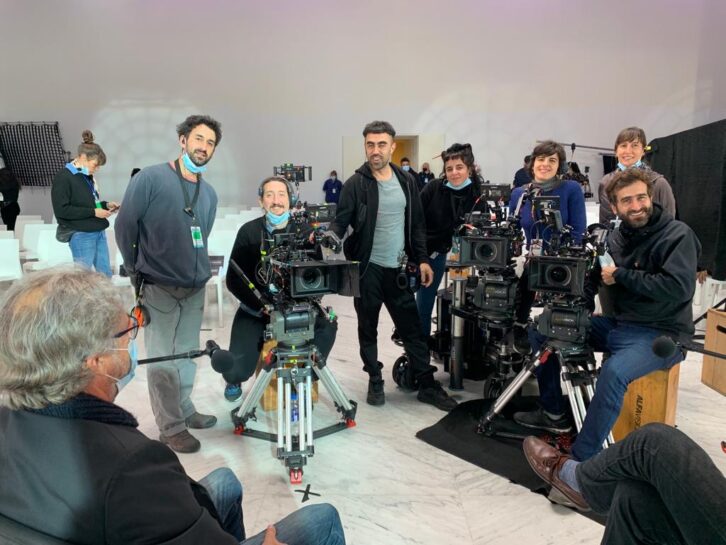
“I used the 75mm for food shots and to separate the foreground from the background. The bokeh that the lens gives is something extraordinary to me. It is not a clinical separation of foreground from background. It is separate but at the same time integrated.”
Production designer Marcelo Pont Vergés and costume designer Connie Balduzzi ensured there was a warm visual palette to work from including royal blue, mustard, olive, and maroon accented with gold and always a strong block of color in the frame.
Maglio took his references from the paintings of French impressionists Paul Gauguin and Paul Cézanne with their vibrant colors and bold composition (such as Cézanne’s ‘Still Life with a Ginger Jar and Eggplants’), as well as from a French recipe book of the 1970s which also contained very colorful food illustrations.
“I had these images in mind when shooting the food for the show. In terms of format, I felt that it was better to present the food often presented on round dishes in a square frame versus a rectangular one. I always had in my mind to take portraits of the city, portraits of characters, and portraits of the food.”
Disney Star+ were steering the production toward shooting on the Sony VENICE but Maglio felt strongly that this story required the Large Format and colour science of an ARRI.
He made camera tests with different cameras and compiled his argument into a document, eventually persuading the show to go with the ALEXA Mini LF.
He recorded ARRIRaw to get as much information as possible to work on color correction in the grade, which was also mastered in HDR. “I chose to work with senior colorist Damian Benetucci who has the right style to execute in the series.”
“We wanted to make the elements of blue sky and green grass as natural as possible and to protect the skin tones but to emphasize the brilliant color and really make it pop as Matisse’s color palette.”
The production had several months to prep for De Niro’s arrival but only a window of ten hours in one week to film his scenes. While scenes featuring De Niro are mostly set in New York, the great actor flew to the set in Buenos Aires. This was in a first-floor apartment building with green screen outside the windows for later replacement of a Manhattan backdrop.
“When the producers told me De Niro was coming I thought, “Wow!, the history of cinema is going to be in front of my camera and I have to light him,” Maglio recalls. “I knew I needed to be sure of what I was doing because we could not afford to make a mistake given our time with him is very short.”
“I felt excited about the challenge ahead of me. I had to manage that exhilaration and isolate myself from the pressure around me, while maintaining my focus on making sure I delivered the final picture that satisfied my aesthetical demands.”
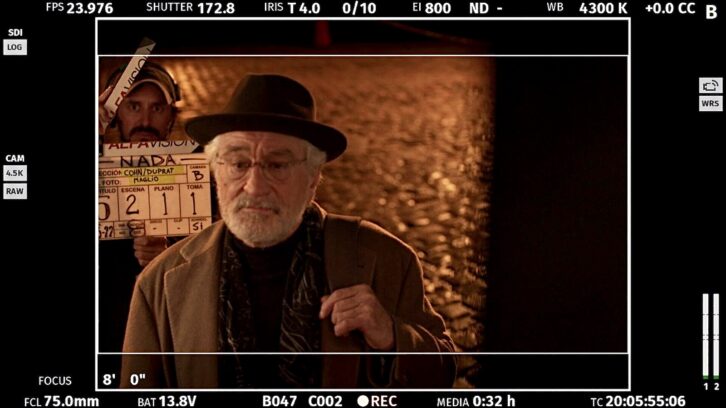
Given the actor’s tight schedule there was little room for multiple takes, so they decided to film multi-camera, using three identically-set-up ALEXA Mini LF.
“Lighting for chroma key against big windows is hard enough but having to light for three cameras was very difficult. I had to study and plan where to put the cameras and lights to make the light feel natural and not hitting his face, Maglio recalls.”
Shooting against chromakey can often feel as if the background is flat, Maglio adds, “but with these lenses it all felt integrated with a natural separation and fall off between foreground and background. It was remarkable.”
They spent a day prepping the lighting using a stand-in. The next day, with 80 people on set – most of them nervous of the big moment – De Niro arrived.
“There was silence on set. Our stand-in double went out of the frame and De Niro came into the frame and every single light fixed perfectly on his face. It was amazing!”
“What’s more, his timing was like a Swiss clock,” Maglio says. “He is a machine. In his movement, his eyes, his face. He had to speak Spanish too. I’ve never seen anyone do what he did. It was perfection.”
# # #


